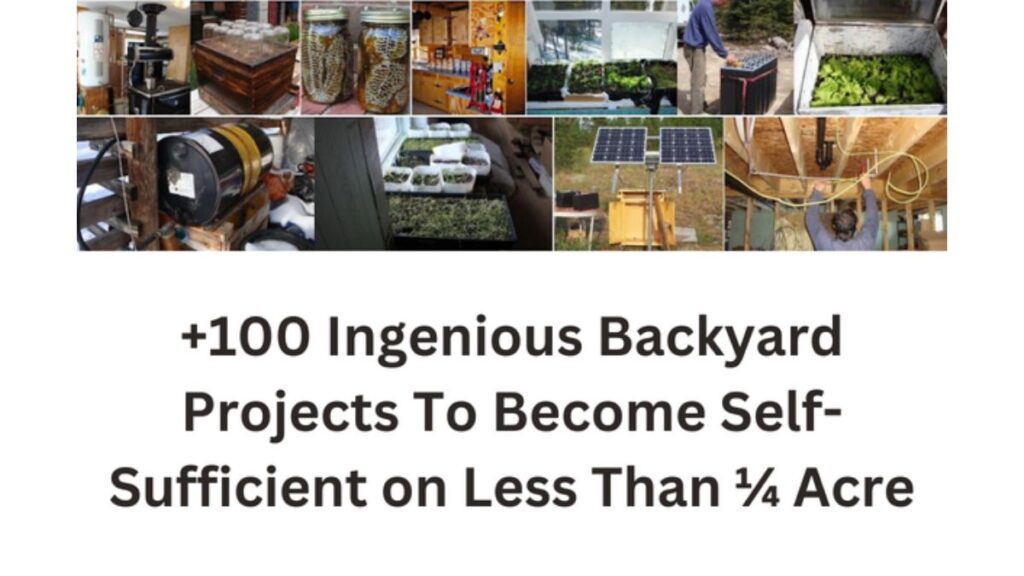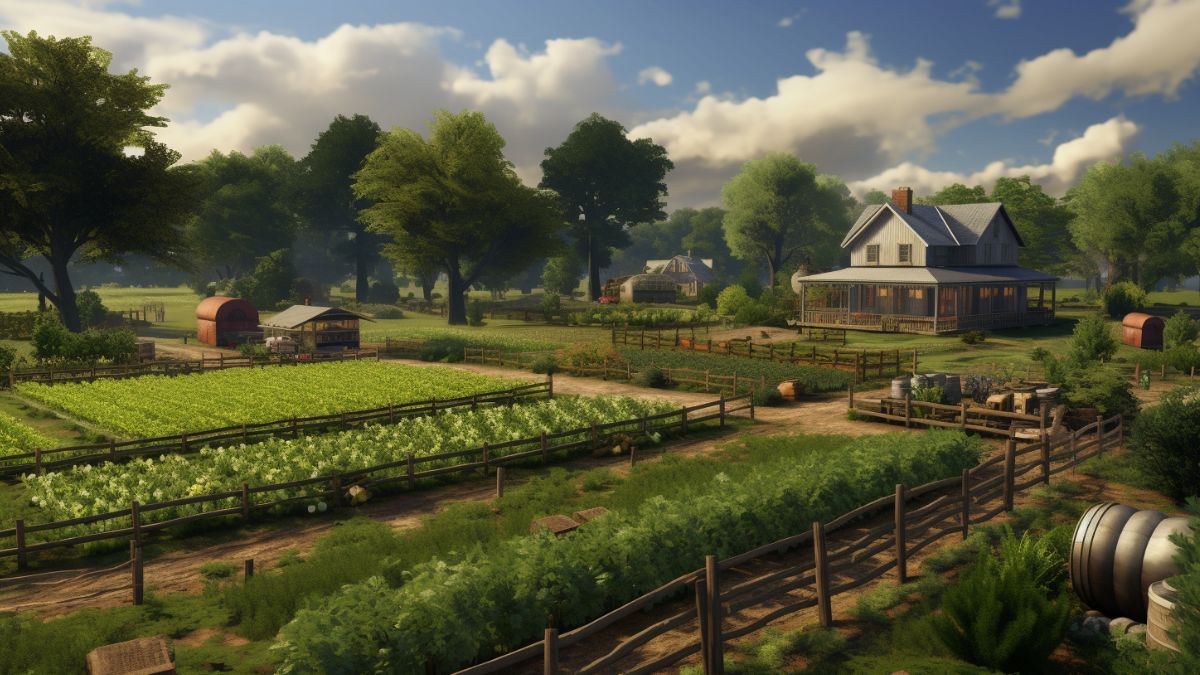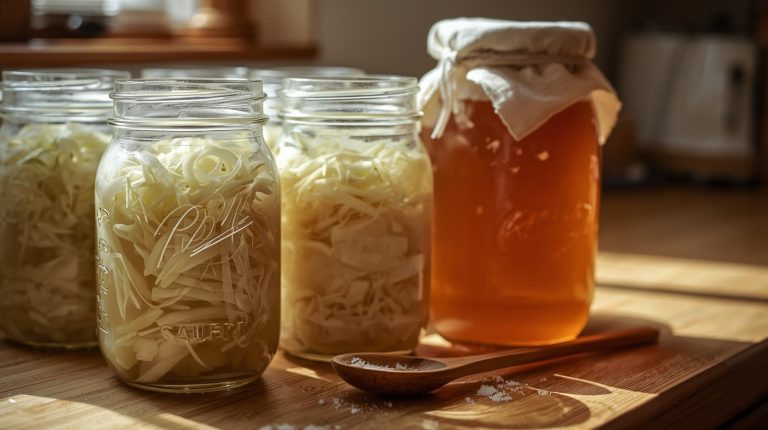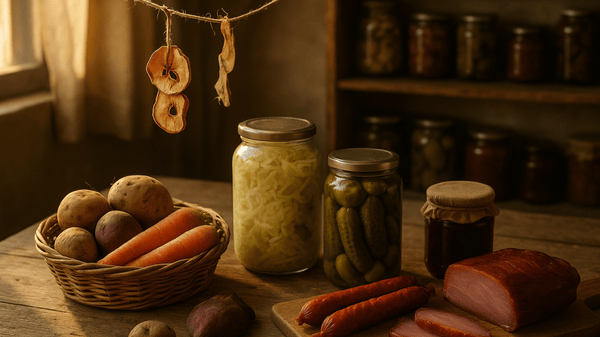Are you tired of relying on others for your basic needs? Are you yearning for a life of independence and self-sufficiency? Look no further! In this transformative guide, we will show you how to become self sufficient and turn your homestead into a self-sufficient paradise.
From growing your own food to harnessing renewable energy, we’ll provide you with practical tips and strategies to create a lifestyle that is both environmentally friendly and financially sustainable. Join us on this fulfilling journey towards self-sufficiency and discover the joy of belonging to a community of like-minded individuals.
Understanding Self-Sufficiency
To truly embark on the journey of self-sufficiency, you must first understand the principles and mindset behind it. Self-sufficiency offers a multitude of benefits, including a sense of empowerment, reduced reliance on external systems, and the ability to live a more sustainable lifestyle. However, it also comes with its own set of challenges, such as the need for knowledge and skills in various areas, as well as the dedication and discipline required to maintain self-sufficiency.
To become self-sufficient, you can start by taking small steps towards independence. Educate yourself on sustainable practices, such as growing your own food, conserving resources, and developing DIY skills. Recognize the importance of self-sufficiency in modern society, where our reliance on external systems is becoming increasingly fragile.
Even in an urban environment, achieving self-sufficiency is possible. Utilize available space for container gardening, explore alternative energy sources, and seek out local resources and communities that promote self-sufficiency. By embracing the principles of self-sufficiency, you can create a more resilient and fulfilling life for yourself and your community.
The Journey Towards Food Self-Sufficiency
How can you achieve food self-sufficiency on your homestead?
Transitioning to a self-sufficient lifestyle can be challenging, but the benefits are worth it. Growing your own food not only provides fresh and nutritious meals, but also reduces reliance on external sources.
Start by creating a plan and setting goals for your homestead. Assess your available space and determine what crops and animals you can sustainably raise.
Consider the challenges of achieving food self-sufficiency in an urban environment and explore options like container gardening or joining community gardens.
The role of community is crucial in self-sufficiency, as you can share resources, knowledge, and support with like-minded individuals. Attend local workshops, join online forums, and connect with others who are on the same journey.

Embracing Resource Conservation
Start conserving resources on your homestead by implementing sustainable practices. Resource conservation is a key aspect of sustainable living, and it involves reducing waste, practicing eco-friendly practices, and embracing environmental stewardship.
By adopting these principles, you can minimize your impact on the environment and create a more self-sufficient lifestyle. Reduce waste by composting organic materials and recycling whenever possible. Choose cloth instead of disposable products to reduce landfill waste. Embrace eco-friendly practices such as harvesting rainwater for irrigation and generating renewable energy.
Gaining Essential DIY Skills
By gaining essential DIY skills, you can actively participate in resource conservation and create a more self-sufficient lifestyle on your homestead. Learning these skills will empower you to take control of various aspects of your life and reduce your dependence on external resources.
Start by mastering self-sufficient cooking techniques, such as making your own bread, growing your own herbs, and preserving food through canning or fermenting. Embrace frugal living strategies to save money and make the most of what you have. Embracing downsizing will help you declutter your life and prioritize what truly matters.
Additionally, explore natural health remedies to promote well-being without relying on chemical-based solutions. By gaining these essential DIY skills, you won’t only become more self-sufficient but also foster a sense of belonging and connection to your homestead.
The Basics of Animal Husbandry
Embrace the responsibility of animal care and nurture on your homestead to cultivate self-sufficiency in animal husbandry. Raising chickens and keeping bees are excellent ways to start your journey. Chickens provide fresh eggs and meat, while bees offer honey and pollination for your garden.
Livestock care is another crucial aspect of animal husbandry, whether it’s goats for milk, sheep for wool, or cows for dairy products. Learning animal husbandry techniques such as proper feeding, sheltering, and health care will ensure the well-being of your animals.
Additionally, hunting and fishing can supplement your food supply and connect you with nature. By honing these skills, you’ll not only become self-sufficient but also foster a deep sense of belonging to the natural world and your homestead.
Foraging and Utilizing Natural Resources
Explore the abundance of edible wild plants and the utilization of natural resources by foraging.
Foraging techniques and sustainable foraging practices can help you achieve self-sufficiency through natural resources. Here are four ways to make the most of what nature has to offer:
- Learn wild food identification: Familiarize yourself with the edible plants in your area. Take a foraging class or consult field guides to confidently identify safe and nutritious wild foods.
- Utilize natural resource foraging: Harvest materials from the environment for various purposes. Collect rainwater for irrigation, air dry clothes instead of using a dryer, and cut your family’s hair at home.
- Practice sustainable foraging: Gather wild foods in a way that ensures their continued abundance. Only take what you need and leave enough for the plants and animals to thrive.
- Incorporate foraged foods into your diet: Experiment with wild ingredients in your cooking. From wild mushrooms to edible flowers, diversifying your diet with wild foods adds nutrition and excitement to your meals.
Achieving Financial Sustainability
To achieve financial sustainability, take steps to prioritize your spending and reduce unnecessary expenses. Start by creating a budget plan to track your income and expenses. This will help you identify areas where you can cut back and save money.
Look for opportunities to generate additional income, such as starting a side hustle or monetizing a hobby. Managing your debt is also crucial for financial independence. Develop a strategy to pay off your debts and avoid accumulating new ones.
Explore different saving strategies, such as automating your savings or setting up an emergency fund. Remember that financial sustainability isn’t about deprivation, but rather about making conscious choices that align with your values and long-term goals.
Sustainable Food Production Techniques
To achieve self-sufficiency in food production, you can start by implementing sustainable techniques. Here are some practical ways to enhance your food production using organic farming methods, permaculture principles, urban gardening strategies, and hydroponic farming methods:
- Embrace organic farming methods: Avoid synthetic pesticides and fertilizers, and instead focus on natural alternatives to promote healthy and nutrient-rich crops.
- Apply permaculture principles: Design your garden to mimic natural ecosystems, utilizing companion planting, polyculture, and efficient use of resources to create a sustainable and self-sustaining food system.
- Explore urban gardening strategies: Utilize small spaces in urban areas for vertical gardening, container gardening, and rooftop gardens to grow your own food in limited spaces.
- Implement hydroponic farming methods: Use nutrient-rich water solutions and controlled environments to grow plants without soil, maximizing space and resources while minimizing water usage.
Related Article: Hydroponics Made Easy: Unlock the Secrets of Modern Gardening.
Food Preservation Methods
Preserve your homegrown food using simple and effective methods. Canning techniques, fermenting foods, drying methods, pickling recipes, and freezing tips are all great ways to ensure your harvest lasts throughout the year.
When it comes to canning, make sure to follow proper safety guidelines and use the appropriate equipment. Fermenting foods like sauerkraut and pickles not only preserves them but also adds beneficial probiotics to your diet. Drying herbs and fruits is a convenient method that retains their flavors and nutrients.
Pickling vegetables in vinegar brine not only extends their shelf life but also gives them a tangy and delicious taste. Lastly, freezing excess produce and meat is a practical way to store them for future use. With these preservation techniques, you can enjoy the fruits of your labor all year round.
Water Conservation Practices
In order to continue preserving your homegrown food and maintaining self-sufficiency, it’s important to implement water conservation practices on your homestead. Here are some practical tips to help you conserve water and make the most of this precious resource:
- Install rain barrels to collect rainwater for watering your plants.
- Utilize greywater irrigation by redirecting wastewater from sinks, showers, and laundry to your garden.
- Choose drought-tolerant crops that require less water to thrive in your climate.
- Invest in water-saving devices like low-flow toilets, faucets, and showerheads to reduce water usage in your home.
By implementing these water conservation practices, you can ensure that your homestead remains sustainable and self-sufficient while minimizing your impact on the environment.
Additionally, consider using non-toxic cleaners made from vinegar and citrus fruit to further promote a healthy and eco-friendly lifestyle.
Related Post: DIY Rainwater Collection Systems for Eco Homes.
Harnessing Renewable Energy
Harnessing renewable energy is essential for achieving self-sufficiency on your homestead. By investing in solar panel installations, you can harness the power of the sun to generate electricity for your home.
Consider the efficiency of wind turbines to capture the energy of the wind and convert it into usable power. Geothermal systems utilize the constant temperature of the earth to provide heating and cooling for your home.
Implementing passive solar design techniques in your home construction allows you to maximize natural light and heat from the sun. Additionally, biomass utilization offers an alternative energy source by converting organic matter into usable energy.
Related Post: DIY Off-Grid Solar System: Ultimate Guide To Power Your Paradise.
DIY Home Repairs and Maintenance
To achieve self-sufficiency on your homestead, start by mastering basic DIY home repairs and maintenance tasks. Here are some essential skills to develop:
- DIY Plumbing: Learn how to fix leaky faucets, unclog drains, and install new fixtures. Understanding your plumbing system will save you money and prevent costly water damage.
- Electrical Repairs: Gain confidence in replacing outlets, switches, and light fixtures. Knowing how to troubleshoot electrical issues will keep your home safe and functional.
- Carpentry Skills: Acquire the ability to build and repair structures such as fences, sheds, and furniture. Carpentry skills are invaluable for maintaining your homestead infrastructure.
- Troubleshooting Appliances: Learn to diagnose and fix common problems with your appliances. Knowing how to repair or replace parts can save you from costly appliance replacements.
- HVAC System Maintenance: Take care of your heating, ventilation, and air conditioning system by learning how to clean filters, perform routine maintenance, and troubleshoot common issues. Proper HVAC maintenance will keep your home comfortable and energy-efficient.
Adopting Sustainable Gardening Practices
To achieve self-sufficiency in your garden, start by implementing sustainable gardening practices that prioritize the use of organic fertilizers, companion planting, and crop rotation.
Organic fertilizers, such as compost and manure, provide essential nutrients to your plants without introducing harmful chemicals into the soil.
Companion planting involves strategically planting different crops together to maximize their benefits and minimize pests. For example, planting marigolds with tomatoes can deter harmful insects.
Crop rotation is another important practice that helps prevent soil depletion and pest buildup. By rotating crops each season, you can maintain soil health and reduce the risk of disease.
Additionally, consider creating a bee-friendly garden by planting flowers that attract bees and other pollinators. Use drought-tolerant crops and implement greywater irrigation to conserve water and reduce your environmental impact.
Related Post: Eco-Friendly Gardening: Green Techniques for a Vibrant Garden.
Exploring Alternative Transportation
Explore different options for reducing your reliance on traditional transportation methods by incorporating alternative transportation solutions into your lifestyle. Here are some sustainable transportation options to consider:
- Public Transportation: Promote public transportation by using buses, trains, or trams. This not only reduces your carbon footprint but also helps alleviate traffic congestion in your community.
- Biking and Walking: Embrace biking and walking for short distances. Invest in a sturdy bicycle and use it for commuting or running errands. Not only is it eco-friendly, but it also promotes physical activity and improves your health.
- Carpooling: Share rides with colleagues, neighbors, or friends who’ve similar destinations. Carpooling reduces the number of cars on the road and saves money on fuel costs.
- Electric or Hybrid Vehicles: Consider investing in electric or hybrid vehicles that have lower emissions and are more fuel-efficient. This contributes to a greener and sustainable future.
Essential Homesteading Skills
Develop essential homesteading skills for a self-sufficient lifestyle. Acquiring these skills will empower you to live sustainably and confidently on your homestead.
Start by learning basic homesteading skills such as gardening, food preservation, and animal husbandry. Cultivate a green thumb and grow your own fruits, vegetables, and herbs. Master the art of canning, fermenting, and drying to preserve your harvest.
Raise chickens for fresh eggs, keep bees for honey and pollination, and consider raising livestock or hunting for meat. Embrace sustainable living practices like composting, rainwater harvesting, and renewable energy generation.
Explore off-grid living tips and self-reliance techniques to reduce your reliance on external resources. Embark on your homestead transformation journey and develop the skills needed for a fulfilling and self-sufficient lifestyle.
Sustainable Waste Management Strategies
Implement sustainable waste management strategies on your homestead by practicing recycling, composting, and minimizing single-use items. Embracing a zero waste lifestyle not only reduces your ecological footprint but also saves you money and promotes a healthier environment.
Here are some practical steps you can take to achieve sustainable waste management:
- Start recycling initiatives: Set up designated recycling bins for different materials such as paper, plastic, glass, and metal. Research local recycling programs and guidelines to ensure proper disposal.
- Master composting techniques: Composting is an excellent way to repurpose organic waste and create nutrient-rich soil for your garden. Learn about composting methods, such as hot composting or vermicomposting, to effectively reduce kitchen and yard waste.
- Reduce single-use plastics: Minimize the use of plastic bags, bottles, and packaging by choosing reusable alternatives like cloth bags, stainless steel water bottles, and glass containers. Opt for sustainable packaging options when purchasing goods.
- Engage in upcycling projects: Give new life to old items by repurposing them creatively. Turn glass jars into candle holders, transform wooden pallets into furniture, or make rugs from old t-shirts. Upcycling reduces waste and adds a unique touch to your homestead.
Natural Health and Wellness Tips
To prioritize your well-being on your journey towards self-sufficiency, start by incorporating these natural health and wellness tips into your daily routine. First, explore the world of natural health remedies and holistic wellness practices. Incorporate herbal medicine into your life by growing medicinal herbs and learning to make herbal teas and tinctures.
Practice mindfulness techniques to reduce stress and promote overall well-being. Additionally, prioritize physical fitness by incorporating regular exercise into your daily routine. Whether it’s through gardening, hiking, or practicing yoga, find activities that you enjoy and that keep you active.
Self-Sufficient Cooking and Meal Preparation
To achieve self-sufficient cooking and meal preparation, start by incorporating fresh, homegrown ingredients into your meals. This not only ensures that you have control over what goes into your food, but it also promotes sustainability and reduces reliance on external sources.
Here are some discussion ideas to help you on your journey:
- Sustainable meal planning: Plan your meals based on what you have available, whether it’s from your garden or preserved foods. This helps you avoid food waste and ensures that you’re utilizing your resources efficiently.
- Homegrown ingredients in recipes: Experiment with incorporating homegrown fruits, vegetables, and herbs into your recipes. Not only will this add a burst of flavor, but it will also give you a sense of pride and satisfaction in knowing that you grew the ingredients yourself.
- Cooking with preserved foods: Learn different methods of food preservation, such as canning, drying, and fermenting. This allows you to enjoy the flavors of your homegrown produce even during the off-season.
- Utilizing alternative cooking methods: Explore cooking methods that don’t rely heavily on electricity, such as outdoor grilling, solar cooking, or using a wood-burning stove. This not only reduces your reliance on conventional energy sources but also adds a unique flavor to your meals.
- Self-sufficient baking and bread making: Learn the art of baking and bread making using homemade ingredients, such as freshly ground flour from your own grain or sourdough starter that you’ve cultured yourself. This allows you to enjoy the simple pleasure of homemade bread while reducing your dependence on store-bought alternatives.
Achieving Financial Independence
How can you achieve financial independence while striving for self-sufficiency on your homestead?
Building financial resilience is essential for achieving financial independence. Start by managing your personal finances effectively. Create a budget and track your expenses to ensure you’re living within your means. Look for opportunities to cut unnecessary expenses and prioritize your needs over wants.
Additionally, focus on building multiple streams of income. Explore different ways to generate income on your homestead, such as selling excess produce, handmade crafts, or offering services like workshops or classes. Diversifying your income will help you achieve financial stability and reduce reliance on a single source of income.
Emergency Preparedness Essentials
As you strive for self-sufficiency on your homestead, it’s important to prioritize emergency preparedness essentials to ensure the safety and well-being of yourself and your family.
Here are four key items to help you be prepared for any emergency:
- Stocking Supplies: Keep your pantry and storage areas well-stocked with non-perishable food and water supplies. This will ensure that you have enough sustenance to last through any emergency situation.
- Emergency Kit: Create an emergency kit that includes essential supplies such as flashlights, batteries, a first aid kit, blankets, and a portable radio. This kit should be easily accessible and ready to grab in case of an emergency.
- First Aid Skills: Learn basic first aid and CPR skills to be able to provide immediate medical assistance in case of injuries or health emergencies. Having these skills can be crucial when professional help isn’t immediately available.
- Evacuation Plan: Develop a detailed evacuation plan that includes designated meeting points, emergency contact information, and routes to safety. Practice this plan with your family to ensure everyone knows what to do in case of an evacuation.
Remember to stay informed about local emergency protocols and resources, as they can provide valuable assistance during times of crisis. By prioritizing these emergency preparedness essentials, you can feel confident in your ability to protect yourself and your loved ones in any situation.
Reviving Old-Fashioned Skills
If you’re looking to become more self-sufficient on your homestead, it’s time to revive those old-fashioned skills that were once essential for daily living.
Relearning traditional crafts is a great way to start. By mastering sewing, you can mend and make your own clothes, creating sustainable clothing that’s both unique and eco-friendly.
In addition, you can make homemade cleaning products using natural ingredients, reducing your reliance on store-bought chemicals.
Embracing natural home remedies allows you to treat common ailments using ingredients from your garden, promoting a holistic approach to wellness.
And when it comes to transportation, consider sustainable options like biking or walking for short distances, carpooling, or using public transportation.
Reconnecting With Food and Nature
To reconnect with food and nature, explore the abundance of edible wild plants in your local surroundings. Take a walk through the woods or fields and discover the hidden treasures that nature has to offer. Here are some ways to immerse yourself in the world of food and nature:
- Community Supported Agriculture (CSA): Join a local farm share program and support local farmers while enjoying a variety of fresh, seasonal produce.
- Farmer’s Markets: Visit your local farmer’s market to connect directly with growers and artisans, and indulge in the vibrant flavors and colors of locally sourced ingredients.
- Wild Food Foraging: Venture into the wilderness and learn to identify and safely harvest edible plants. Discover the joys of gathering your own food from the wild.
- Farm-to-Table Dining: Treat yourself to a farm-to-table dining experience, where you can savor delicious meals made with ingredients sourced from nearby farms.
- Nature Walks: Take leisurely walks in forests, parks, and trails to appreciate the beauty of nature. Observe the flora and fauna around you, and feel a sense of belonging in the natural world.
Embracing Downsizing and Minimalism
Embrace the freedom of a simpler life by downsizing your living space. By adopting strategies for downsizing and minimalism, you can experience the benefits of a simpler lifestyle.
Start by organizing and decluttering your surroundings, letting go of excess possessions that no longer serve a purpose. Begin small by cleaning out a closet or drawer, and gradually eliminate clutter that hasn’t been used in the last 6 months.
Embrace the principles of reuse, recycle, and reduce to make the most of your belongings. As you simplify your living space, you’ll find contentment in having just what you need.
Additionally, frugal living hacks can help you cut expenses and save money. Shop at second-hand stores, downgrade your cable subscription, and limit eating out to special occasions.
Strategies for Frugal Living
Practice frugality to achieve financial independence and sustainability in your self-sufficient journey. Here are some frugal living tips to help you on your way:
- Create a budget and track your expenses: Knowing where your money is going is the first step in making economical choices.
- Implement cost-saving techniques: Look for ways to reduce your monthly expenses, such as cutting unnecessary services or shopping at second-hand stores.
- Embrace a thrifty lifestyle: Learn to make meals from minimal ingredients, shop smart by waiting for items to go on sale, and limit eating out to special occasions.
- Prioritize needs over wants: By distinguishing between essential and non-essential expenses, you can save money and make budgeting strategies that align with your financial goals.
Eating Seasonally and Debt Reduction
By prioritizing seasonal eating and reducing debt, you can take significant steps towards self-sufficiency and financial independence.
Eating seasonally not only supports local farmers and reduces your carbon footprint, but it can also help you save money on groceries.
Start by creating a budget for groceries and allocate a portion of it specifically for seasonal produce. Plan your meals around what’s in season and available locally, as these items tend to be more affordable.
To make the most of seasonal produce, consider preserving it through canning, freezing, or drying methods. This will allow you to enjoy the flavors and nutritional benefits of these foods all year round.
Additionally, meal planning can help you avoid unnecessary spending and reduce food waste.
Conclusion
Congratulations on taking the first step towards self-sufficiency! By implementing the strategies outlined in this guide, you can create a lifestyle that isn’t only environmentally friendly but also financially sustainable.
Did you know that according to a study by the American Homestead Association, homesteaders who grow their own food can save up to $2,000 per year on grocery bills? Start your homestead transformation today and reap the benefits of a self-sufficient life.





